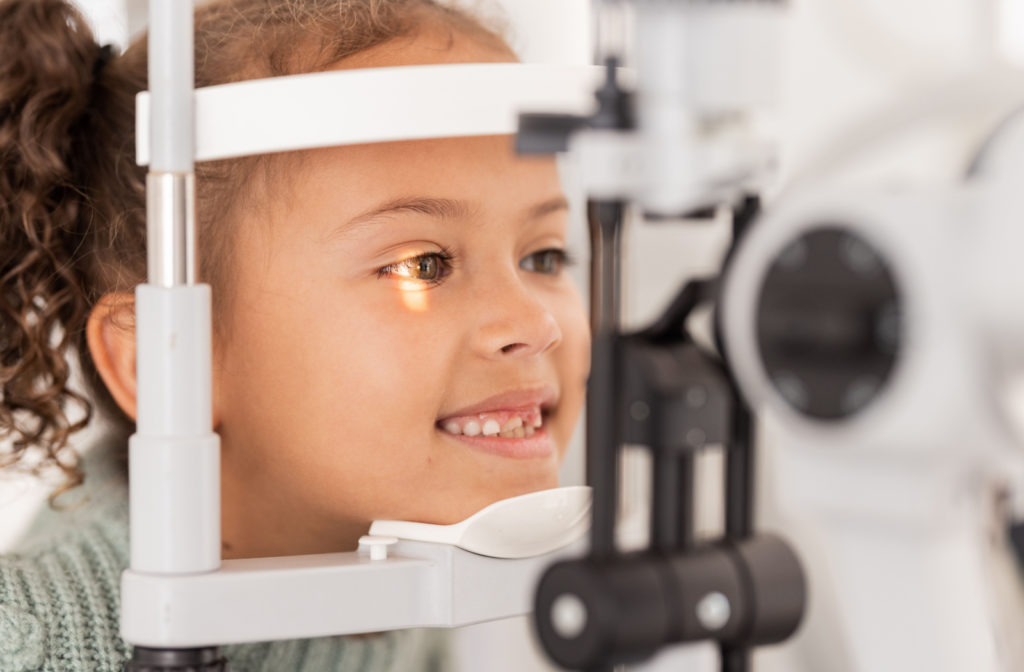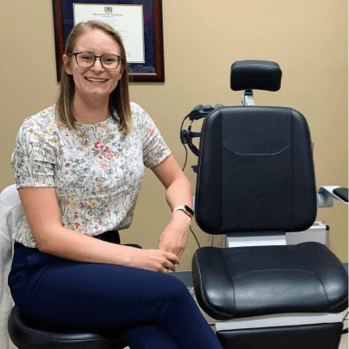Strabismus, or crossed eye, is a condition in which one eye is not pointed in the same direction as the other (eye turn). It can be startling to notice one or both of your child’s eyes appear crossed.
It’s natural for newborns to appear cross-eyed in their first few months, which usually resolves by around 4–6 months of age. However, if your child continues to experience crossed eyes beyond this age, it’s a good idea to have their eyes checked by their eye doctor. Early treatment can often correct eye alignment issues, preventing potential long-term vision issues.
Strabismus is just one possible childhood eye condition that can affect their vision. Myopia (nearsightedness), Hyperopia (farsightedness), amblyopia (lazy eye), and astigmatism are other common conditions that can benefit from early intervention.
What Is Strabismus?
Strabismus is a condition in which one eye is not pointed in the same direction as the other (eye turn). Strabismus can occur as an inward eye turn ( esotropia) or an outward eye turn (exotropia). A vertical strabismus is known as a hypertropia or a hypotropia.
A strabismus can occur constantly or intermittently. It can also alternate between eyes, meaning either eye can turn anytime. Strabismus is not necessarily a muscle weakness but rather the brain’s inability to use the eyes together as a team.
Causes of Strabismus
Strabismus occurs as a physical adaptation to a neurological issue. There are several causes, including:
- Uncorrected refractive error
- Poor vision in one eye
- Trauma
- Visual stress
- Brain injury
- Genetics
Complications of Strabismus
Like other eye conditions, strabismus should be treated by an eye doctor as early as possible to prevent further complications or worsening symptoms.
Some complications of strabismus include:
- Amblyopia (lazy eye)
- Blurred vision
- Eye strain
- Eye fatigue
- Headaches
- Double vision
- Poor 3D vision
- Poor coordination and motor development
When Should You Talk to Your Child’s Eye Doctor About Strabismus?
Babies’ eyes can appear crossed because their eye coordination is still developing. Typically, their eyes will straighten out as they grow, and their vision will improve. This phenomenon is called pseudostrabismus or false strabismus.
But if you notice that one or both of your child’s eyes are wandering as they get older, it’s a good idea to book them in for a comprehensive eye examination. Strabismus usually first appears between birth and 21 months. These are critical periods for visual development, and as such, it’s recommended that babies have their first eye exam between 6 and 9 months.
Can Strabismus Turn into Amblyopia?
Amblyopia, or lazy eye, is another common childhood vision issue. It is when one eye does not see as well as the other, even with glasses. These conditions share similarities, so you may wonder if strabismus can turn into amblyopia as your child ages.
When strabismus constantly occurs in childhood, the brain can favour the straight eye, resulting in poorer vision in the turned eye. This is known as strabismic amblyopia. It’s the result of the brain attempting to avoid double vision.
Regular eye exams are essential for detecting vision problems like this early. With proper treatment and monitoring, the brain can learn to use both eyes together and improve vision in the turned eye.
Treating Strabismus
Strabismus can be treated with a few different methods.
Vision Therapy
Vision therapy can help prevent worsening vision. Vision therapy is a noninvasive, personalized plan that strengthens the connection between the eyes and the brain. It’s not about exercising the eye muscles but improving your visual system.
Your child’s vision therapy program will typically consist of weekly visits where they work with their eye doctor to perform various activities designed to improve visual skills. They may be given activities to perform at home as well.
Several tools may be used during vision therapy to assist:
- Therapeutic lenses
- Prisms and filters
- Electronic targets and timing mechanisms
- Balance boards
Eyeglasses
Eyeglasses, contact lenses, or prism lenses can also be effective in relieving the symptoms of strabismus, particularly if they result from an uncorrected refractive error.

Book Your Child a Comprehensive Eye Examination
Children won’t outgrow strabismus. Early treatment is key to helping children with strabismus achieve better visual skills and prevent permanent vision loss.
You do not need to panic, but it is crucial to book your child an eye exam so their optometrist can rule out strabismus or any other childhood eye condition or begin treatment.
Call us at Beyond 20/20 Optometry to book a comprehensive eye examination for your child. Our experienced eye doctors will work with you and your child to develop a plan to help set them up for their future.




